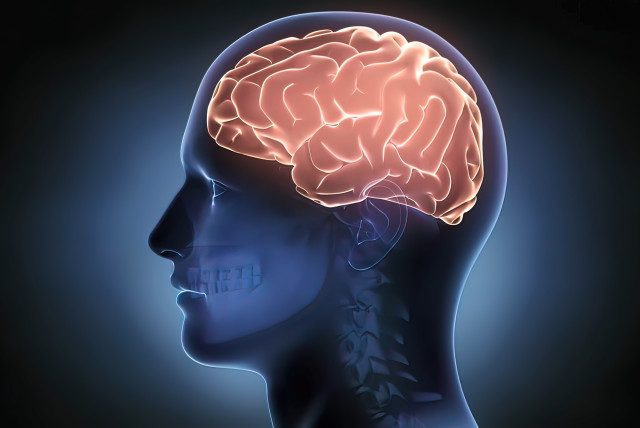Why do we help others? New study reveals part of brain responsible for altruism

According to the new paper, our selflessness and willingness to do good deeds is governed by a specific region in the brain.
Does upbringing, religious beliefs or just being nice induce us to help others? Observant Jews would argue that studying the Torah and other sources as children encourages us to do good deeds.
But according to UK researchers who wrote in the prestigious journal, Nature Human Behavior, and studied patients with brain damage, our selflessness and willingness to do such good deeds is governed by a specific region in the brain. They published their study under the title “Human ventromedial prefrontal cortex is necessary for pro-social motivation.”
Learning about where in the brain ‘helping’ decisions are made is important for understanding how people might be motivated to tackle large global challenges, such as climate change, infectious disease, and international conflict, declared lead author Prof. Patricia Lockwood, a cognitive and social neuroscientist researcher at the Universities of Birmingham and Oxford.
She and her colleagues showed for the first time how a region called the ventromedial prefrontal cortex (vmPFC) has a critical role in encouraging “pro-social” behaviors. It is also vital for finding new approaches to treating disorders of social interactions.
Every day, we make choices between effort and reward like whether to go to the gym or stay at home, or between helping a colleague and watching TV. It’s not always pleasant to make an effort, they wrote. “If two courses of action are connected with different amounts of effort but the same reward, people will choose the option requiring less effort.
Being unwilling to make an effort has important implications for everyday behavior and characterizes apathy, a clinical condition of reduced motivation that is common across multiple psychiatric and neurological disorders. It is therefore essential to understand the neural mechanisms of how costs such as effort and benefits such as rewards are integrated into value-guided behavior, they declared.
“Pro-social behaviors are essential for addressing global challenges. Yet helping others is often effortful, and many humans don’t like to make such efforts. Understanding how helping decisions are processed in the brain is extremely important,” they continued.
The study
IN THE STUDY, the researchers focused on the vmPFC, a region located right at the front of the brain that is known to be important for decision-making and other executive functions. Previous studies using magnetic resonance imaging (MRI scanning) have linked the vmPFC to choices that involve a trade-off between the rewards available and the effort required to obtain rewards. However, these techniques cannot show whether a part of the brain is essential for these functions. Three groups of participants were recruited for the study ov whom 25 patients had vmPFC damage, 15 patients had damage elsewhere in the brain, and 40 people were healthy age and gender-matched control participants. These groups allowed the researchers to test the specific impact of damage to vmPFC.Each participant attended an experiment where they met another person anonymously. They then completed a decision-making task that measured how willing they were to exert physical effort (squeezing a grip-force device) to earn rewards (bonus money) for themselves and for the other person.By enabling participants to meet – but not see – the person they were “working” for in advance, researchers were able to convey the sense that participants’ efforts would have real consequences but hide any information about the other person that could affect their decisions.
Each choice the participants made varied in how much bonus money for them or the other person was available, and how much force they would have to exert to obtain the reward. This allowed the researchers to measure the impact of reward and effort separately, and to use advanced mathematical modeling to precisely quantify people’s motivation. The results of the study clearly showed that the vmPFC was necessary for motivation to help others. Patients with vmPFC damage were less willing to choose to help others, exerted less force even after they did decide to help, and earned less money to help others compared to the control groups.In a further step, the researchers used a technique called lesion-symptom mapping which enabled them to identify even more specific subregions of the vmPFC where damage made people particularly antisocial and unwilling to exert effort for the other person. Surprisingly, damage to a nearby but different subregion made people relatively more willing to help.Co-lead author Dr. Jo Cutler added: “As well as better understanding pro-social motivation, this study could also help us to develop new treatments for clinical disorders such as psychopathy, where understanding the underlying neural mechanisms can give us new insights into how to treat these conditions.”“This region of the brain is particularly interesting because we know that it undergoes late development in teenagers, and also changes as we get older,” Lockwood concluded. “It will be really interesting to see whether this area of the brain can also be influenced by education – can we learn to be better at helping others?”
Jerusalem Post Store
`; document.getElementById("linkPremium").innerHTML = cont; var divWithLink = document.getElementById("premium-link"); if (divWithLink !== null && divWithLink !== 'undefined') { divWithLink.style.border = "solid 1px #cb0f3e"; divWithLink.style.textAlign = "center"; divWithLink.style.marginBottom = "15px"; divWithLink.style.marginTop = "15px"; divWithLink.style.width = "100%"; divWithLink.style.backgroundColor = "#122952"; divWithLink.style.color = "#ffffff"; divWithLink.style.lineHeight = "1.5"; } } (function (v, i) { });

